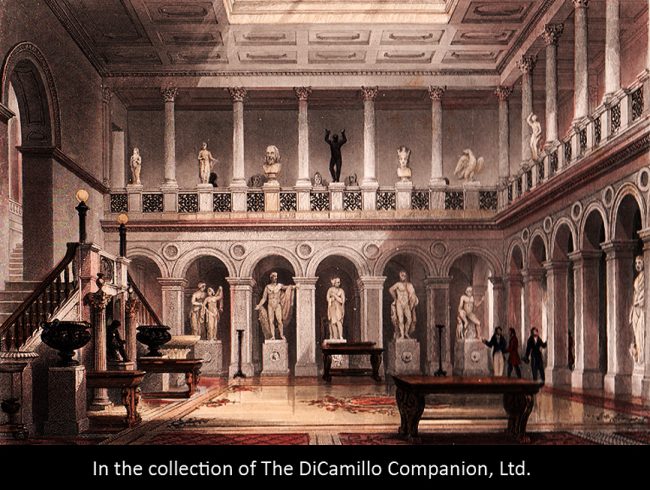
The entrance hall from a hand-colored 1842 engraving
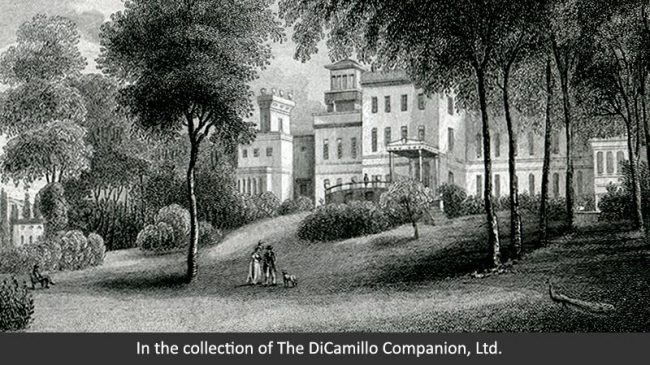
The garden (east) facade from a 19th century engraving
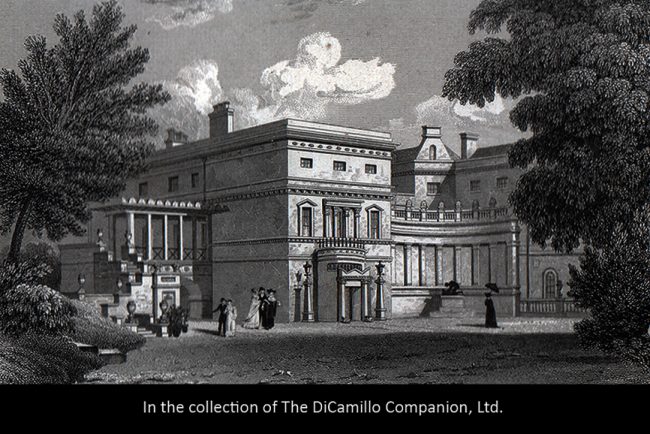
The garden (east) facade from an 1826 engraving in "Neale's Views of Seats"
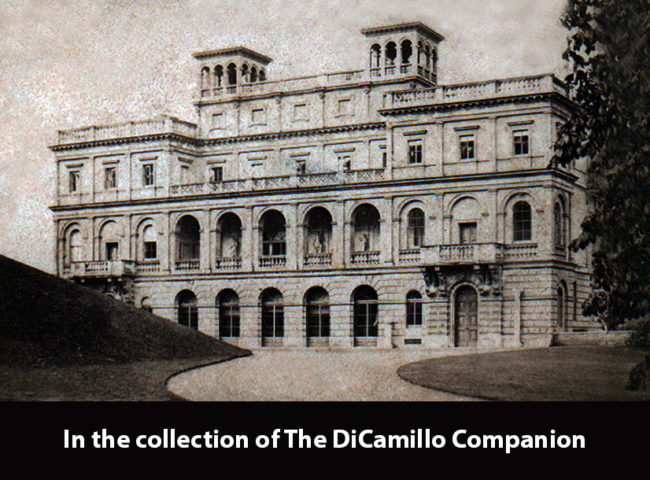
The entrance facade from a circa 1860-80 photograph
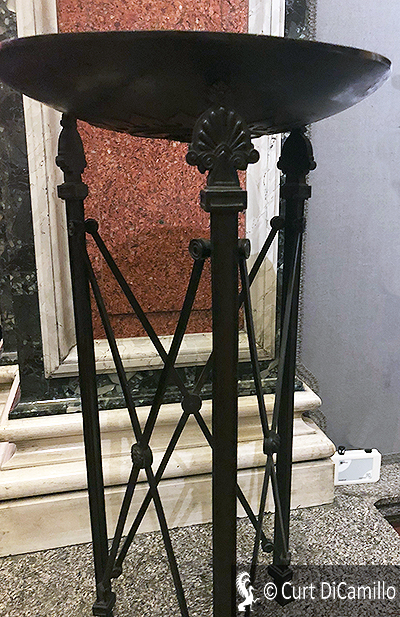
A circa 1802 bronze tripod designed by Thomas Hope and probably made by Alexis Decaix. This piece was once installed at The Deepdene. Today in the collection of the Fitzwilliam Museum, Cambridge.
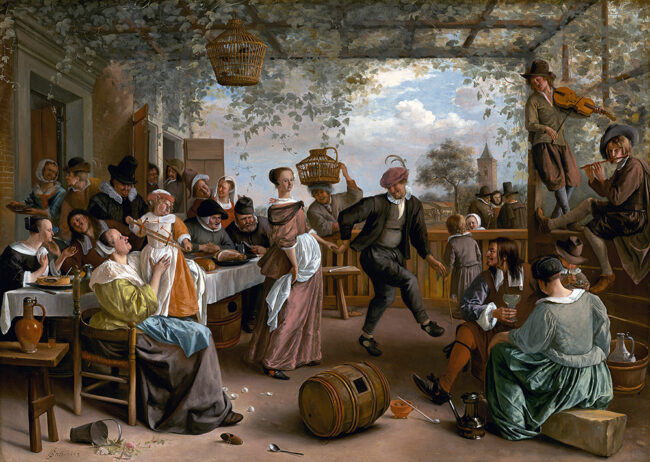
Jan Steen. "The Dancing Couple." 1663. Widener Collection, National Gallery of Art, Washington. This image is in the public domain.
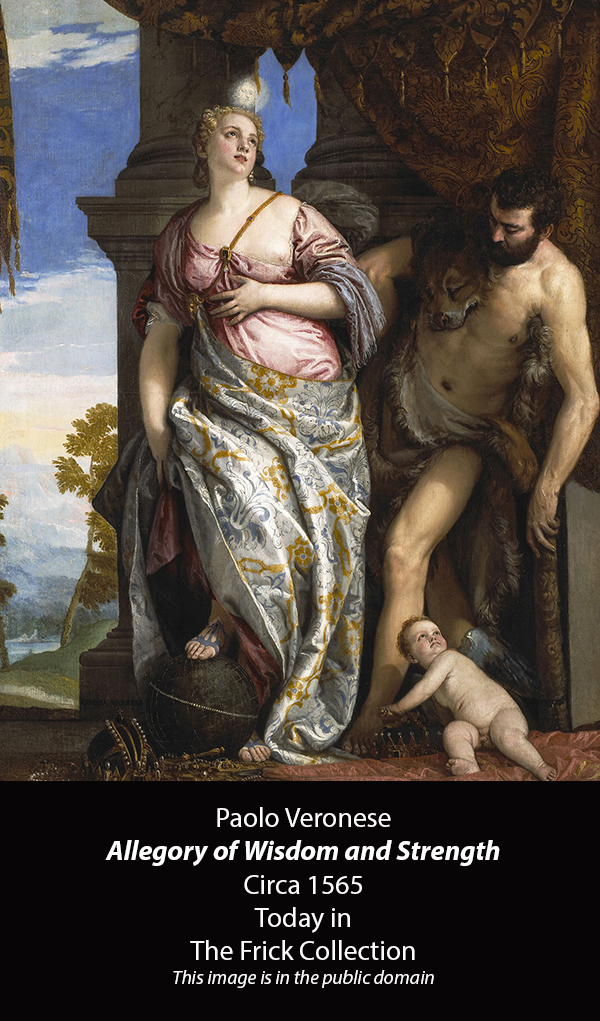
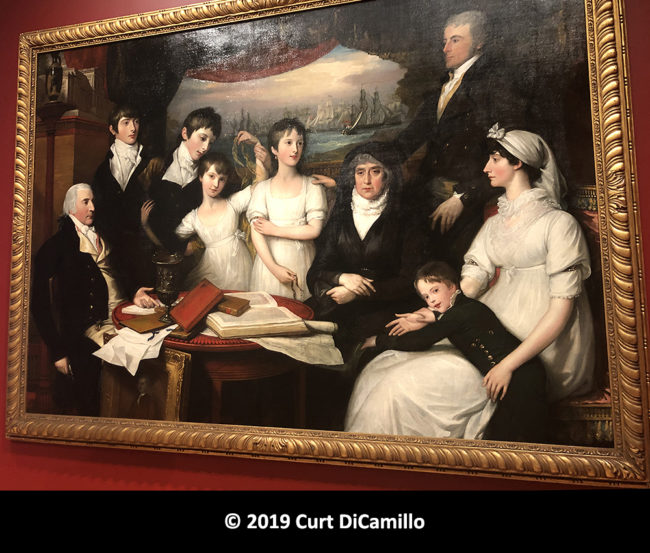
"The Hope Family," Benjamin West, 1802. Today in the collection of the Museum of Fine Arts, Boston.
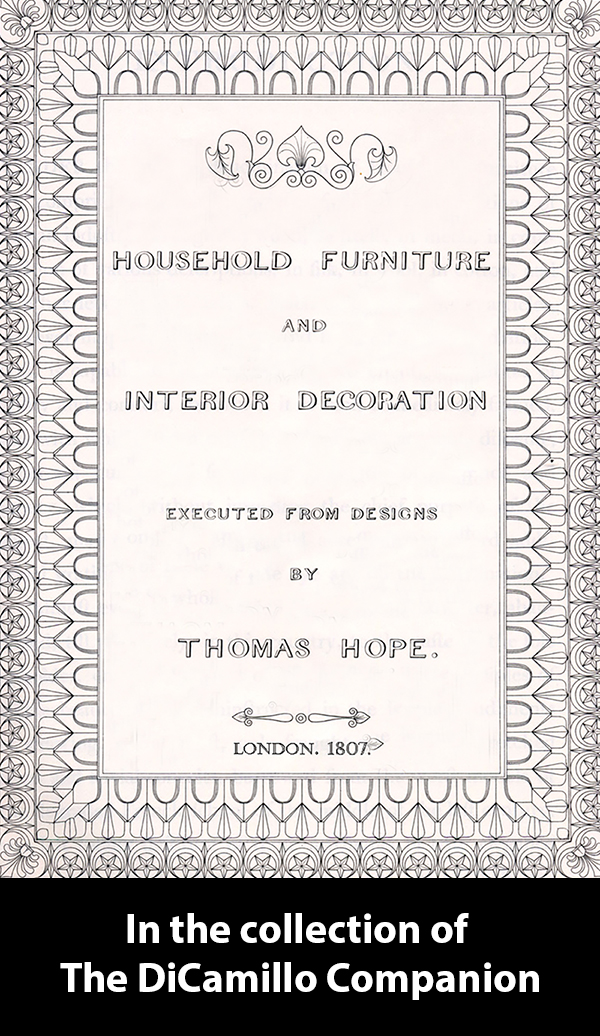
The 1807 title page from "Household Furniture and Interior Decoration"
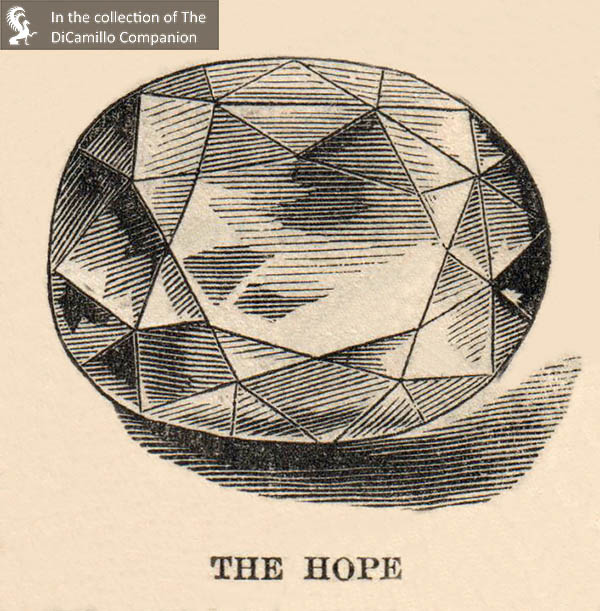
The Hope Diamond as it appeared in the mid-19th century. Illustration from an 1866 issue of "Harper's New Monthly Magazine"
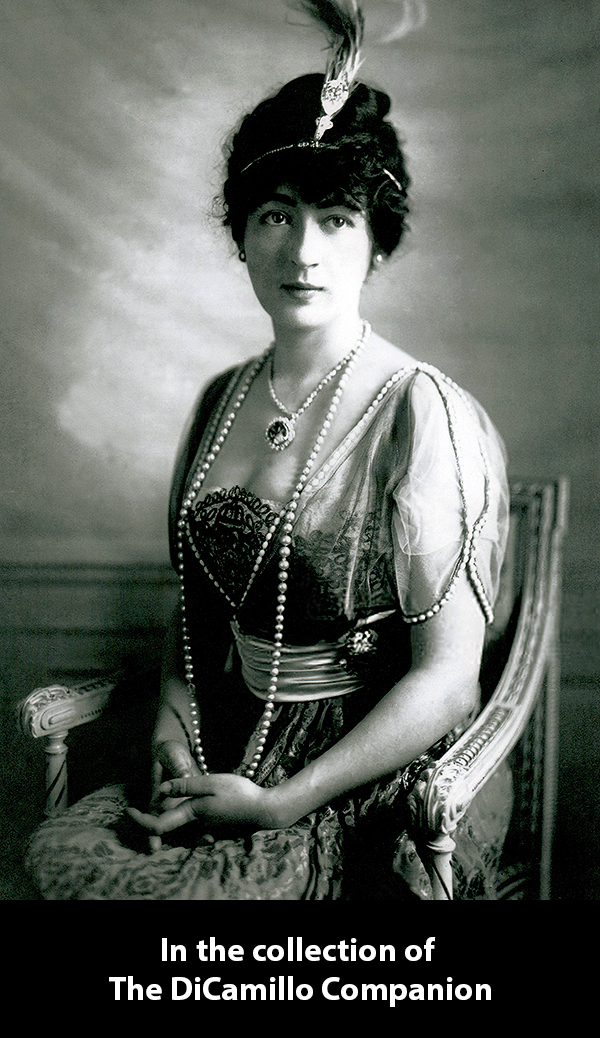
Evalyn Walsh McLean wearing the Hope Diamond in a 1915 photograph
Earlier Houses: There was at least one earlier house on, or near, the site of the 18th-19th century house.
House & Family History: The Deepdene was originally part of the Knepp Estate, a property of the Howard family. Charles Howard, later 10th Duke of Norfolk, built the house in the Palladian style between 1769 and 1775. Deepdene's appearance during this time can be seen in a painting today in the collection of the Marylebone Cricket Club. In 1807 The Deepdene was sold to Sir Thomas Hope, a millionaire collector and major style trendsetter in the early 19th century. Sir Thomas was born in Amsterdam in 1769, the son of a wealthy banking family that had emigrated from Scotland to Holland at the end of the 17th century. By the late 18th century their bank, Hope & Company, was a major influence in the national affairs of Holland and a power throughout Europe (the family fled Holland in 1795, just ahead of Napoleon's forces, and settled in London). In 1802 Hope & Company, through its London office, helped finance the Louisiana Purchase, despite the fact that Britain was at war with France. Technically, the United States did not purchase Louisiana from Napoleon, but from Hope & Company and Barings Bank. Payment was made in U.S. bonds, which Napoleon sold to Barings at a discount of 87.50 per $100. As a result, Napoleon received only $8,831,250 in cash. Alexander Baring, working for Hope & Company, met in Paris with the French director of the public treasury, François Barbé-Marbois, then traveled to the United States to pick up the bonds and deliver them to France. Thomas Hope spent an amazingly long time (1787-95) on the Grand Tour, during which he was almost certainly inspired in his concept of design, particularly his idea of synthesizing many styles into a coherent whole. In 1799 Hope acquired his famous house on Duchess Street in London (Hope House); the house was built in the 1760s to the designs of Robert Adam as part of the Portland Place development and featured the French style of a courtyard in the front with a garden in the back. Sir John Soane was a known admirer of Hope's Duchess Street house (q.v. Hope House, London); Soane's Lincoln Inn's Field house (now Sir John Soane's Museum) is today the closest remnant we have of what Hope's house was once like (the Duchess Street house was demolished in 1851 and most of its famous contents moved to The Deepdene). The Duchess Street house had an impressive Picture Gallery that sported four Greek Doric columns, possibly the first use ever of such columns in a domestic British interior (much of The Deepdene's interiors were furnished in the same style as the Duchess Street house). Hope wrote the book "Household Furniture and Interior Decoration" in 1807 (see "Images" section) and thus coined the phrase interior decoration (in 1809 he authored another influential book entitled "Costume of the Ancients"). He was one of the most ardent proponents for the Greek Revival style in its "original" severe form. Such was Hope's influence that he successfully maneuvered to get Wyatt's designs for Downing College, Cambridge, thrown out and replaced by the more "correct" Greek designs of William Wilkins. Hope employed William Atkinson to remodel The Deepdene in 1818; Atkinson was back again in 1823 to add a large south wing to the house. Thomas Hope died on February 2, 1831 at the age of sixty-one. In the 1840s The Deepdene was further remodeled and enlarged in the Italianate style by Hope's son, Henry Thomas Hope, who added an 11-bay front with twin towers, in addition to a two-story entrance hall. Disraeli wrote part of "Coningsby" at Deepdene. On the death of Henry Thomas Hope's wife, Anne, in 1862, the Deepdene Estate was left to her grandson, Lord Francis Hope-Pelham-Clinton, later 8th Duke of Newcastle. Lord Francis was hopeless at managing his finances and was declared bankrupt in 1894. Subsequently, The Deepdene was leased to Lord William Beresford (the third son of the 4th Marquess of Waterford). From 1911 until 1914 the house was let to Almeric Paget. In 1917 the majority of the Hope Collection at The Deepdene was sold (see more about this in the "Collections" section). In 1920 the house and 50 acres were sold; in 1921 a further 2,200 acres were sold. In the interwar years the house was operated as a hotel by Madame Coletta, who owned The Deepdene from 1918 until 1939. The Southern Railway Company purchased the house in 1939; the Southern was later nationalized and became a part of BritRail, which occupied the house until 1967, when it was sold to Federated Homes Ltd., a development company. In 1969 The Deepdene was demolished; an office block now stands in its place.
Collections: In 1917 the majority of the Hope Collection at Deepdene was sold; most of Thomas Hope's furniture was purchased by Edward Knoblock, who displayed it at the Beach House in Worthing, where it was a significant spark in the revival of the Regency style. Today the Victoria & Albert Museum, London, and the Royal Pavilion in Brighton contain significant collections of furniture designed by Thomas Hope. There was an Egyptian style bed at The Deepdene copied from a plate in Vivant Denon's 1802 "Egypte." Two large 16th century allegorical paintings by Paolo Veronese, “Wisdom and Strength" (see "Images" section) and “Choice Between Virtue and Vice," which once hung at The Deepdene, have been, since 1912, in The Frick Collection, New York. Jan Steen's 1663 painting, "The Dancing Couple," which one hung at The Deepdene, is today part of the Widener Collection at the National Gallery of Art, Washington (see "Images" section). The famous Hope Athena, an oversized 1st century AD Roman marble statue of the goddess, after a late 5th century BC Greek original, was excavated in Rome in 1797 and purchased by Thomas Hope with the idea that it captured the spirit of the original gold and ivory statue of Athena made for the Parthenon by Pheidias. William Randolph Hearst purchased the statue, from whence it came into the collection of the Los Angeles County Museum of Art, where it remains today. Henry Philip Hope (died 1839) was Thomas's younger brother; like Thomas, Henry Philip was also a collector, especially of gems. It was Henry Philip who acquired the world's largest deep blue diamond. Over one billion years old, this 45-carat stone soon carried his family’s name: The Hope Diamond. The jewel is believed to have originated in India, where it was purchased, or stolen, in 1666 by French gem merchant Jean-Baptiste Tavernier. Tavernier had the diamond cut into a triangular-shaped stone of 115 carats and named it after himself: The Tavernier Blue. Circa 1668 Tavernier sold the jewel to King Louis XIV, who renamed it the Blue Diamond of the Crown of France (more commonly called the French Blue). The king had the diamond recut to 67.125 carats and set on a cravat pin. In the 1740s Louis XV had the French Blue set into his emblem of the Order of the Golden Fleece. In 1792, during the chaos of the French Revolution, the French Blue was stolen, after which it was probably cleaved into at least two stones. In the early 19th century the jewel that we today know as the Hope Diamond appeared in London at a reduced size of 45.54 carats (almost its current weight). Sometime in this period, probably in the 1830s, it was purchased by Henry Philip Hope. The diamond stayed in the ownership of the Hope family until 1901, after which it had a number of different owners. By 1910 the stone was owned by Pierre Cartier, who purchased it for 550,000 francs. In 1911 Cartier sold the gem to Edward Beale McLean, whose father owned “The Washington Post” newspaper. McLean was married to Washington socialite Evalyn Walsh McLean, whose father, Thomas Francis Walsh, discovered one of the largest gold mines in America: The Camp Bird Gold Mine in Colorado (see photo of Mrs. McLean wearing the Hope Diamond in the "Images" section). In 1949 New York jeweler Harry Winston purchased the famous stone from Mrs. McLean’s heirs and exhibited it around the United States. Winston also had the Hope Diamond's bottom facet slightly recut to increase its brilliance, reducing its weight from 45.54 to 45.52 carats. In 1958 Winston donated the diamond to the National Museum of Natural History in Washington (part of the Smithsonian Institution) as the first piece of a proposed a national gem collection. The Hope Diamond is supposedly insured today for $250 million.
Comments: In the 19th century the garden designer John Claudius Loudon described Deepdene as "...a group [of buildings] so rich in classic forms and combinations that no one can duly appreciate its beauties whose mind is not thoroughly imbued with Italy and the fine arts. It is in short, an example of what the Germans would call the ecstatic in architecture." David Watkin has called Hope's Deepdene "...the most startling Picturesque country house in England."
Garden & Outbuildings: The grounds of The Deepdene were famous in the 17th century. Contemporary references are made to Charles Howard's amphitheater garden, together with grottoes and a subterranean passage. Aubrey and John Evelyn both made visits and praised what they found. During the time of Thomas Hope the grounds were particularly noted for the Theatre of the Arts, which contained a collection of antique marble sculpture. The Hope Mausoleum, the only remaining building on the grounds of The Deepdene, was built and consecrated in 1818 for the burial of Hope's young son, Charles, who died in 1818; Thomas Hope was buried there in 1831, followed by other members of his family. In 1941 the 6th Duke of Newcastle was the last interment in the mausoleum. In 1954 the mausoleum was permanently sealed with concrete and buried with earth up to the level of the roof. The 7th Duke of Newcastle left the Hope Mausoleum and the surrounding land to the town of Dorking in 1960 to be used as a public open space. Sited in a picturesque dell, the large archaic Greek style mausoleum is Thomas Hope's only extant building; it was neglected for decades, until, in 2003, the idea of excavating and restoring the mausoleum was proposed by a number of amenity groups, including the Mausolea and Monuments Trust. In 2010 excavation work began; in 2016 the magnificent mausoleum was completely restored and triumphantly opened to the public, complete with reproduction Hope furniture.
Architect: Alexander Roos
Date: 1850sArchitect: William Gowan
Date: 1769-75Architect: William Atkinson
Date: 1823Architect: William Atkinson
Date: 1818-19John Bernard (J.B.) Burke, published under the title of A Visitation of the Seats and Arms of the Noblemen and Gentlemen of Great Britain and Ireland, among other titles: 2.S. Vol. I, p. 218, 1854.
John Preston (J.P.) Neale, published under the title of Views of the Seats of Noblemen and Gentlemen in England, Wales, Scotland, and Ireland, among other titles: 2.S. Vol. III, 1826.
Title: Biographical Dictionary of British Architects, 1600-1840, A - HARDBACK
Author: Colvin, Howard
Year Published: 2008
Reference: pgs. 81, 438, 538
Publisher: New Haven: Yale University Press
ISBN: 9780300125085
Book Type: Hardback
Title: Los Angeles County Museum of Art
Author: Stevens, Matt; Butler, Nola (Editors)
Year Published: 2003
Reference: pg. 87
Publisher: London: Thames & Hudson Ltd.
ISBN: 0500203601
Book Type: Softback
Title: Regency Furniture and Interior Decoration: Classic Style Book of the Regency Period
Author: Hope, Thomas
Year Published: 1971
Reference: pgs. v, vi, viii, x, xiii
Publisher: New York: Dover Publications
ISBN: 0486217108
Book Type: Softback
Title: Mausolus: The Journal of The Mausolea and Monuments Trust
Author: NA
Year Published: NA
Reference: No. 6, Jul 2003, pg. 1; May 2010, pg. 3
Publisher: London: The Mausolea and Monuments Trust
ISBN: NA
Book Type: Magazine
Title: Country Life (magazine)
Author: NA
Year Published: NA
Reference: Oct 25, 2001, pg. 93; Jul 17, 2003, pg. 66
Publisher: London: Future plc
ISBN: NA
Book Type: Magazine
Title: England's Lost Houses From the Archives of Country Life
Author: Worsley, Giles
Year Published: 2002
Reference: pgs. 162-165
Publisher: London: Aurum Press
ISBN: 1854108204
Book Type: Hardback
Title: Neoclassical Source Book, The
Author: Clifton-Mogg, Caroline
Year Published: 1991
Publisher: New York: Rizzoli International Publications, Inc.
ISBN: 0847813924
Book Type: Hardback
Title: Buildings of England: Surrey, The
Author: Nairn, Ian; Pevsner; Nikolaus; Cherry, Bridget (Reviser)
Year Published: 1971
Publisher: London: Penguin Books
ISBN: 140710213
Book Type: Hardback
Title: No Voice From the Hall: Early Memories of a Country House Snooper
Author: Harris, John
Year Published: 1998
Publisher: London: John Murray
ISBN: 0719555671
Book Type: Hardback
House Listed: Demolished
Park Listed: Grade II*
Past Seat / Home of: SEATED AT EARLIER HOUSES: Thomas Howard, 5th Duke of Norfolk, 17th century. SEATED AT 18TH-19TH CENTURY HOUSE: Charles Howard, 10th Duke of Norfolk, 18th century. Charles Merrick Burrell, early 19th century. Thomas Hope, 1807-31; Henry Thomas Hope, 1831-62; Lord Francis Hope-Pelham-Clinton, later 8th Duke of Newcastle, 19th-20th centuries. Lord William Beresford, early 20th century. Almeric Paget, 1911-1914. Madame Coletta, 1918-39.
Current Ownership Type: Demolished
Primary Current Ownership Use: Demolished
Ownership Details: The grounds are today a public park
House Open to Public: Grounds Only
Historic Houses Member: No